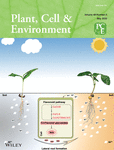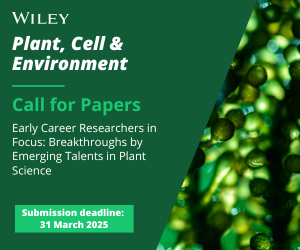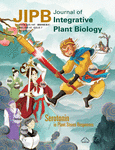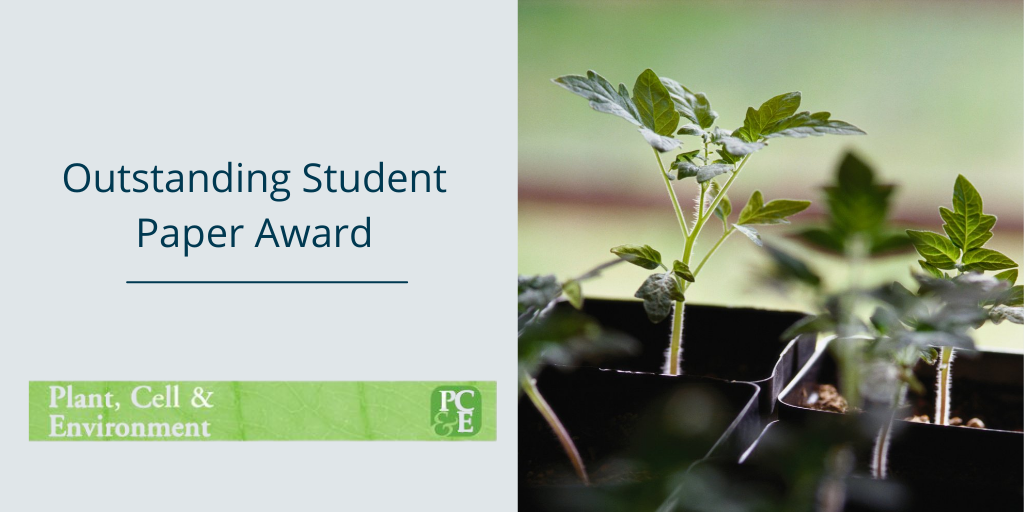Journal list menu
Export Citations
Download PDFs
COVER IMAGE
Outside Front Cover Image
- Page: i
- First Published: 02 April 2025
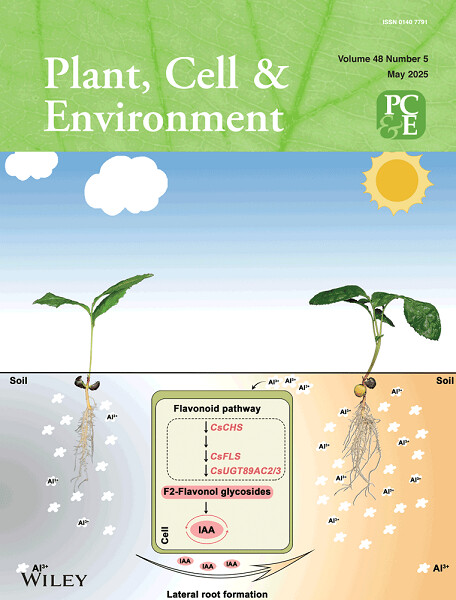
Outside Front Cover: The cover image is based on the article Crucial Role of Aluminium-Regulated Flavonol Glycosides (F2-Type) Biosynthesis in Lateral Root Formation of Camellia sinensis by Sanyan Lai et al., https://doi.org/10.1111/pce.15372.
ISSUE INFORMATION
ORIGINAL ARTICLE
Proteome Reprogramming and Acquired Stress Tolerance in Potato Cells Exposed to Acute or Stepwise Water Deficit
- Pages: 2875-2894
- First Published: 05 December 2024
Plants respond to environmental stresses by modulating a complex network of molecular mechanisms according to the duration and intensity of the insult. Herein, we report the proteome reprogramming in potato cells under short and long-term water deficit, providing unique molecular signatures of potato cell stress adaptation.
Microplastics and Nanoplastics Alter the Physicochemical Properties of Willow Trees and Lead to Mortality in Leaf Beetle Larvae
- Pages: 2895-2909
- First Published: 05 December 2024
-
Long-term exposure to micro- and nanoplastics make the willow plants Salix maizhokunggarensis unsuitable for herbivores to consumption by increasing leaf hardness, causing mouthpart wear, disruption of the gut microbiota, and epithelial cell rupture in Plagiodera versicolora, ultimately increasing mortality.
Plant Architecture Optimizes the Trait-Based Description and Classification of Vegetation
- Pages: 2910-2922
- First Published: 05 December 2024
The incorporation of plant architecture optimizes the trait-based classification of vegetation. Due to the plastic variation in plant architectural traits, coastal dwarf forests have formed a distinct vegetation type.
CRISPR-Cas9 Mediated Gene Editing Platform Through Callus-to-Plant Regeneration and Functional Analysis of DoALA4─DoALA6 in Dendrobium officinale
- Pages: 2923-2936
- First Published: 06 December 2024
We have established an effective system for stable gene editing in Dendrobium officinale and have successfully knocked out DoALA4─DoALA6 genes in D. officinale and obtained gene-edited plants. We revealed that DoALA4─DoALA6 affect the growth of D. officinale and the ability of disease resistance.
Formation of Apoplastic Barriers to Radial O₂ Loss in Rice Roots: Effects of Low-O₂ and High-Fe Conditions, and the Roles of Suberin, Glycerol Esters, and Iron Plaques
- Pages: 2937-2949
- First Published: 10 December 2024
Rice roots form apoplastic barriers to limit radial O₂ loss and toxic Fe uptake. In low-O₂ conditions, tight barriers containing enhanced suberin and glycerol esters are formed in the exodermis. In high Fe conditions, partial barriers develop, characterized by a suberized exodermis and iron plaques covering roots.
MangroveDB: A Comprehensive Online Database for Mangroves Based on Multi-Omics Data
- Pages: 2950-2962
- First Published: 11 December 2024
We constructed a comprehension omics database for mangroves research community. MangroveDB provides several tools for data analysis, which facilitates further exploration, especially for researchers performing wet-lab experiments.
Disguised Blessings: A Mechanistic Understanding of the Beneficial Outcomes Triggered by Partial K Replacement With Na in Two Eucalyptus Species Under Drought Stress
- Pages: 2963-2985
- First Published: 11 December 2024
-
This study offers insights into how partial replacement of K by Na enhances physiological functions and metabolic performance, elucidating the trade-offs between drought tolerance and maximized growth in Eucalyptus species.
-
The ideal rate of K replacement with Na upregulates the ion and water transport systems, maximizes enzymatic antioxidant performance and biomass production, and decreases oxidative stress.
OPINION
Stomatal Parameters in a Changing Environment
- Pages: 2986-2997
- First Published: 12 December 2024
We recommend that stomatal slope parameters (g1) be inferred by inversion so that variations in g1 may be attributed to variations physiological and environmental conditions. Understanding g1 will advance predictions of plant gas exchange and performance under global climate.
ORIGINAL ARTICLE
Chloroplastic Aspartyl-tRNA Synthetase Is Required for Chloroplast Development, Photosynthesis and Photorespiratory Metabolism
- Pages: 2998-3011
- First Published: 15 December 2024
-
AspRS3 dysfunction in Arabidopsis impairs chloroplast development, photosynthetic efficiency, and growth.
-
Elevated CO2 ameliorates the asprs3-1 phenotype by reducing Rubisco oxygenation and photorespiration, highlighting the crucial role of aminoacyl-tRNA synthetases in photorespiratory metabolism.
Sec24C Participates in Cuticular Wax Transport by Facilitating Plasma Membrane Localization of ABCG5
- Pages: 3012-3026
- First Published: 15 December 2024
- •
The membrane protein SAV1 modified the chemical composition of very-long-chain fatty acids in cuticular waxes.
- •
The defective phenotype of sav1-1 in sugar-free medium resembles that of abcg5.
- •
SAV1 interacts with ABCG5 and function in wax transport by altering the subcellular localisation of ABCG5.
Foliar Water Uptake Supports Water Potential Recovery but Does Not Affect Xylem Sap Composition in Two Salt-Secreting Mangroves
- Pages: 3027-3037
- First Published: 16 December 2024
Short Exposure to Full Moonlight Has a Long-Term Impact on Brassica juncea Cell Activity and Growth
- Pages: 3038-3051
- First Published: 16 December 2024
The study of the impact of an overlooked yet prominent environmental factor, the moon, on growth of mustard plants revealed that short-time exposure to moonlight initiates a developmental switch that subsequently influences cellular activities over the long term, resulting in improved growth.
REVIEW
Root Exudation: An In-Depth Experimental Guide
- Pages: 3052-3065
- First Published: 16 December 2024
This review addresses the variability in root exudate studies by examining how experimental factors—such as spatial, temporal and analytical parameters—affect exudation. It emphasizes the need for standardized methods and provides a guide to improve experimental design and reporting in the field.
ORIGINAL ARTICLE
CONSTANS-Like and SHORT VEGETATIVE PHASE-Like Genes Coordinately Modulate TERMINAL FLOWER 2 to Control Dormancy Transitions in Pinus tabuliformis
- Pages: 3066-3084
- First Published: 16 December 2024
The PtTFL2 gene functions as both an environmental sensor and dormancy marker in Pinus tabuliformis. It is regulated by cold-dependent and independent pathways involving the photoperiod-responsive PtCOL1 and PtSVP-like (SVL) genes. The CO-TFL module controls fall dormancy (ecodormancy), while the SVP-TFL module manages the shift to endodormancy in winter.
SmHSFA8 Enhances the Heat Tolerance of Eggplant by Regulating the SmEGY3-SmCSD1 Module and Promoting SmF3H-mediated Flavonoid Biosynthesis
- Pages: 3085-3104
- First Published: 17 December 2024
-
SmHSFA8 enhances the heat tolerance of eggplant by activating SmHSPs expression, mediating the SmEGY3-SmCSD1 module and promoting SmF3H-mediated flavonoid biosynthesis.
-
This finding is highly important for adaptation to climate change and eggplant production under high-temperature stress.
WRKY1-Mediated Interconversion of MeSA and SA in Neighbouring Apple Plants Enhances Defence Against Powdery Mildew
- Pages: 3105-3117
- First Published: 17 December 2024
The volatile compound MeSA-mediated plant–plant communication is crucial for enhancing group immunity. The transcription factor WRKY1 increases the SA content and enhances the resistance to powdery mildew in neighbouring plants by promoting the conversion of MeSA to SA and inhibiting the conversion of SA to MeSA.
Altering Carotene Hydroxylase Activity of DcCYP97C1 Affects Carotenoid Flux and Changes Taproot Colour in Carrot
- Pages: 3118-3135
- First Published: 18 December 2024
Our study demonstrated that manipulation of DcCYP97C1 was sufficient to influence carotenoid flux, change carrot colour and for high lutein production.
CCT39 Transcription Factor Promotes Chlorophyll Biosynthesis and Photosynthesis in Poplar
- Pages: 3136-3150
- First Published: 19 December 2024
PpnCCT39 in poplar enhances chlorophyll biosynthesis and photosynthesis, impacting leaf morphology and chloroplast structure, highlighting its critical role in nucleocytoplasmic interactions.
OPINION
Importance of Timing of Dark Acclimation for Estimating Light Inhibition of Leaf Respiratory CO2 Efflux
- Pages: 3151-3158
- First Published: 20 December 2024
The degree of inhibition of leaf respiration by light is often studied, but the methods used and the results obtained are variable. We suggest that in the future daytime leaf respiration is measured 3 min after dark acclimation to avoid under-estimating the degree of light inhibition of leaf respiration. This will most likely speed up future surveys and perhaps also result in less inter-study variation in the calculated degree of light inhibition of leaf respiration.
ORIGINAL ARTICLE
Carboxylation and Oxygenation Kinetics and Large Subunit (rbcL) DNA Sequences for Rubisco From Two Ecotypes of Plantago lanceolata L. That Are Native to Sites Differing in Atmospheric CO2 Levels
- Pages: 3159-3170
- First Published: 24 December 2024
-
This study examines the influence of Mg2+ and Mn2+ on carboxylation and oxygenation by rubisco purified from two ecotypes of Plantago lanceolata adapted to different CO2 atmospheres.
-
Specificity for CO2 over O2 for rubiscos from both ecotypes was higher when the enzymes were bound to Mg2+ than Mn2+.
TECHNICAL REPORT
Coupling Modelling and Experiments to Analyse Leaf Photosynthesis Under Far-Red Light
- Pages: 3171-3184
- First Published: 24 December 2024
- •
This study introduces a combined modelling and experimental approach to quantify the effect of far-red light on photosynthesis.
- •
A single parameter representing this effect is calculated for Solanum dulcamara, Lactuca sativa and Phaseolus vulgaris.
ORIGINAL ARTICLE
GLR3.6T807I Mutation of Casuarina equisetifolia Is Associated With a Decreased JA Response to Insect Feeding by Lymantria xylina
- Pages: 3185-3198
- First Published: 24 December 2024
Lymantria xylina feeding increases phosphorylation (on Thr807) level of CeGLR3.6 to induce the synthesis of jasmonic acid, further promotes the flavonoids accumulation against insect feeding in Casuarina equisetifolia.
Abscisic Acid and Ethylene Antagonistically Regulate Root Endodermal Suberization to Mitigate Nonuniform Salt Stress in Cotton
- Pages: 3199-3216
- First Published: 24 December 2024
A new split-root system was employed to investigate the response of cotton seedlings to nonuniform salt stress, based on germination paper. The root endodermal barrier plays a role in maintaining ion homoeostasis in cotton. ABA and ethylene have opposite effects on root endodermal suberization to mitigate nonuniform salt stress.
OPINION
Revealing the Hidden Role of Capacitance in the Water Flow Through Plants to the Atmosphere
- Pages: 3217-3224
- First Published: 24 December 2024
The overlooked role of capacitance is revealed theoretically for vapor flow and by dimensional analogy for liquid flow. It combines with conductance to attribute distinctly the physiological and physical contributions to the quantitative formulation of plant transpiration and sap flow.
ORIGINAL ARTICLE
Stomatal Plasticity Maintains Water Potential Homeostasis in Pinus radiata Needles
- Pages: 3225-3235
- First Published: 24 December 2024
Our study highlights the importance of considering plasticity in the stomatal traits for accurate prediction of plant responses under future climate change. We found large variation in maximum stomatal conductance associated with the acclimation of soil-stem hydraulic conductance to temperature and water stress treatments. However, the response of stomata and water potential to vapor pressure deficit was highly conserved.270
Transcriptional Reprogramming Deploys a Compartmentalized ‘Timebomb’ in Catharanthus roseus to Fend Off Chewing Herbivores
- Pages: 3236-3256
- First Published: 24 December 2024
Here, we revealed a HIVE-mediated transcriptional reprogramming in vinca plants that allocates their metabolic resources for chemical defence at a normal temperature, when herbivory pressure is high, but switches to cold tolerance under a cooler temperature, when insect infestation is secondary.
Histone Modification-Dependent Transcriptional Regulation of Defence Genes in Early Response of Arabidopsis to Spodoptera litura Attack
- Pages: 3257-3268
- First Published: 25 December 2024
The early timing of defence gene activation after the onset of herbivore damage is regulated by histone modifications that are highly dependent on specific histone acetyltransferases/deacetylases (HAC1/HDA6) with TPL/TPR corepressors in Arabidopsis thaliana.
Short-Term High Light Stress Analysis Through Differential Methylation Identifies Root Architecture and Cell Size Responses
- Pages: 3269-3280
- First Published: 25 December 2024
High-resolution DNA methylation data analysis in Arabidopsis reveals gene networks that participate in short-term high light stress response. These networks show correspondence with changes in plant stress phenotype.
REVIEW
Revisiting Endoplasmic Reticulum Homeostasis, an Expanding Frontier Between Host Plants and Pathogens
- Pages: 3281-3292
- First Published: 25 December 2024
We summarize recent advances in the manipulation of host ER homeostasis by pathogens, further review key counteracting strategies employed by plants to maintain ER homeostasis during infection, and finally propose several suspending questions in this evolving field.
ORIGINAL ARTICLE
ScDREBA5 Enhances Cold Tolerance by Regulating Photosynthetic and Antioxidant Genes in the Desert Moss Syntrichia caninervis
- Pages: 3293-3313
- First Published: 26 December 2024
Transcriptome analysis at 4°C and −4°C revealed that photosynthesis and ROS scavenging pathways play important roles in the cold response of Syntrichia caninervis, and A-5 type of DREB transcription factors are the hub genes related to cold resistance. ScDREBA5, which shares a common origin with CBFs, was upregulated by ~1000-fold after freezing stress, and significantly enhanced the cold tolerance of S. caninervis and Physcomitrella patens by regulating the expression of CORs, photosynthesis-related and ROS scavenging genes.
Corner's Rules and Their Linkages With Twig Functions and Tree Productivity in Simple- and Compound-Leaved Tree Species
- Pages: 3314-3325
- First Published: 29 December 2024
Size spectra of Corner's rules traits were identified in twigs of both simple- and compound-leaved tree species, but the two functional groups diverged in investment-return scaling relationships. Larger leaf and terminal stem sizes led to more efficient resource acquisition and faster growth rates.
OsPIL15-Induced Delay in Rice Heading Date via Direct Binding to the OsLF Promoter is Dependent on Functional Phytochrome B
- Pages: 3326-3336
- First Published: 29 December 2024
-
OsPIL15, a phytochrome-interacting factor-like gene, delayed the rice heading date partially via binding to the promoter of OsLF to upregulate OsLF.
-
Furthermore, the delay in heading date induced by OsPIL15 was found to be dependent on the functional phytochrome B.
CsCIPK20 Improves Tea Plant Cold Tolerance by Modulating Ascorbic Acid Synthesis Through Attenuation of CsCSN5-CsVTC1 Interaction
- Pages: 3337-3351
- First Published: 30 December 2024
- •
The regulatory networks of low temperature-response in Camellia sinensis remain largely unknown.
- •
In this study, we uncovered that CsCIPK20 competes with CsVTC1 to interact with CsCSN5, thereby protecting CsVTC1 from degradation mediated by CsCSN5 and contributing to AsA accumulation and freezing tolerance in tea plants.
Immune Priming Promotes Thermotolerance, Whereas Thermopriming Suppresses Systemic Acquired Resistance in Arabidopsis
- Pages: 3352-3363
- First Published: 31 December 2024
Experienced plants achieve higher tolerance levels to stresses such as pathogens and heat. Localized pathogen inoculation protects plants against heat shock, similar to acquired thermotolerance; in contrast, elevated temperature suppresses pathogen-mediated systemic acquired resistance.
Microbial Biotic Associations Dominated Adaptability Differences of Dioecious Poplar Under Salt Stress
- Pages: 3364-3378
- First Published: 02 January 2025
Under the stress, the male plants enriched more prebiotics and probiotics, effectively alleviating the stress damage. The keystone taxa promoted the cooperation of bacteria and improved the host tolerance by regulating microbial interactions.
Carbon Dynamics Under Drought and Recovery in Grapevine's Leaves
- Pages: 3379-3390
- First Published: 05 January 2025
We describe the grape leaf water–carbon relation. Under drought, the plants limit their growth and carbon export to conserve their nonstructural carbohydrates. The phloem remained functional even under extreme drought, allowing for recovery of carbon export after rehydration.
HTT1, a Stearoyl-Acyl Carrier Protein Desaturase Involved Unsaturated Fatty Acid Biosynthesis, Affects Rice Heat Tolerance
- Pages: 3391-3405
- First Published: 05 January 2025
HTT1 encodes a chloroplast-localized SAD desaturase involved in the biosynthesis of unsaturated C18:1 fatty acid to cope with high-temperature stress by maintaining membrane stability in rice, which could facilitate the improvement of crops and their adaptation to rising global temperature.
Stomatal and Hydraulic Redundancy Allows Woody Species to Adapt to Arid Environments
- Pages: 3406-3414
- First Published: 05 January 2025
-
Functional redundancy is considered a pivotal insurance mechanism.
-
Our results indicate that species from arid environments have greater stomatal redundancy and lower hydraulic redundancy, which prevents the loss of photosynthesis and water transportation; thus, stomatal redundancy might be the key adaptive mechanism for plants to adapt to drought conditions.
PmRGL2/PmFRL3–PmSVP Module Regulates Flowering Time in Japanese apricot (Prunus mume Sieb. et Zucc.)
- Pages: 3415-3430
- First Published: 05 January 2025
Our research investigates the regulatory mechanisms governing flowering time in Prunus mume, a valuable model plant for studying dormancy and flowering mechanisms in perennial species. Through comprehensive ChIP-Seq analysis, we explored the role of PmRGL2 at different stages of bud dormancy. We demonstrated that PmFRL3 protein acts in conjunction with PmRGL2 protein to regulates downstream PmSVP and PmSVP-like genes. Our findings elucidate the clustered interaction between PmRGL2, PmFRL3, and the PmSVPs gene family, shedding light on the molecular pathways underlying flowering regulation in Prunus mume.
Single-Cell RNA Sequencing Reveals the Developmental Landscape of Wheat Roots
- Pages: 3431-3447
- First Published: 06 January 2025
We reported the scRNA-seq transcriptomes of single cells from root tips of the wheat Chinese spring (CS) cultivar, defined cell-type-specific marker genes and identified most of the major cell types, which contributing to a better understanding of wheat cultivar (CS) root development at unprecedented resolution.
Hydraulic Properties of a Rock-Soil-Root System: Insights From Fraxinus ornus L. Saplings Growing on Different Carbonate Rocks
- Pages: 3448-3458
- First Published: 08 January 2025
-
Plant roots can extract water from porous and highly conductive rocks (Breccia), but not from more compact ones (Dolostone), especially when plants grow in rocky substrate or experience water stress, and thus have low root hydraulic conductivity and low rates of water extraction from rocks.
-
Our data support the hypothesis that rocks represent important water stores for plants growing in rock-dominated habitats, and that heterogeneous rock properties translate into different rates of water delivery to root systems.
The CmTGA1–CmRbohD Cascade Confers Resistance Against Chrysanthemum White Rust by Promoting Reactive Oxygen Species Generation
- Pages: 3459-3470
- First Published: 08 January 2025
-
CmTGA1 binds to CmRbohD, resulting in a ROS burst.
-
The rapid accumulation of ROS enhances SOD and POD activities and catalysers lignin biosynthesis, thereby improving the resistance of chrysanthemum to CWR.
The Vacuolar Inositol Transporter BvINT1;1 Contributes to Raffinose Biosynthesis and Reactive Oxygen Species Scavenging During Cold Stress in Sugar Beet
- Pages: 3471-3486
- First Published: 08 January 2025
-
Inositol exported from the vacuole via the tonoplast inositol transporter BvINT1;1 contributes to raffinose synthesis and scavenging of reactive oxygen species in sugar beet (Beta vulgaris subsp. vulgaris) taproots during cold.
REVIEW
Epigenetic Mechanisms Driving Adaptation in Tropical and Subtropical Plants: Insights and Future Directions
- Pages: 3487-3499
- First Published: 08 January 2025
-
This review highlights how epigenetic mechanisms, including DNA methylation, histone modifications, and noncoding RNA activity, drive stress resilience in tropical and subtropical plants, offering insights into adaptation strategies and applications for plant resilience under climate change.
ORIGINAL ARTICLE
Convergent Isobilateral Leaves Increase the Risk for Mangroves Facing Human-Induced Rapid Environmental Changes
- Pages: 3500-3511
- First Published: 08 January 2025
-
Mangroves with convergently evolved isobilateral leaves, while enhancing local adaptation, increase vulnerability to human-induced rapid environmental changes, emphasising the need for targeted conservation of adaptive traits facing climate change.
Circadian Proteomics Reassesses the Temporal Regulation of Metabolic Rhythms by Chlamydomonas Clock
- Pages: 3512-3528
- First Published: 08 January 2025
To understand the impact of clock regulation beyond transcription we studied the circadian proteome dynamics in Chlamydomonas reinhardtii. Our study showed robust concurrent rhythms of several key proteins associated with important metabolic pathways. We envisage that in-depth circadian proteomics studies will complement transcriptomics for a comprehensive understanding of clock regulation of metabolism.
Non-Additive Gene Expression in Carbon and Nitrogen Metabolism Drives Growth Heterosis in Populus deltoides
- Pages: 3529-3543
- First Published: 09 January 2025
High-hybrids exhibit HPH and MPH in key enzymes of carbon–nitrogen metabolism. Hybrids inherit parental genes in a dynamically non-additive manner, non-additive DEGs in carbon–nitrogen metabolism co-regulatecoregulate growth heterosis by regulating carbohydrate accumulation, enzyme activity and respiratory energy consumption. GRF4–DELLA interaction contributes to growth heterosis.
LbHKT1;1 Negatively Regulates Salt Tolerance of Limonium bicolor by Decreasing Salt Secretion Rate of Salt Glands
- Pages: 3544-3558
- First Published: 09 January 2025
This study demonstrates that the HKT-type protein HKT1;1 negatively regulates salt tolerance of recretohalophytes by decreasing salt secretion rate of salt glands.
Nitrogen Assimilation Plays a Role in Balancing the Chloroplastic Glutathione Redox Potential Under High Light Conditions
- Pages: 3559-3572
- First Published: 09 January 2025
-
Plant lines mutated in GS2 and GOGAT exhibited decreased PSII efficiency, and disrupted GSH redox potential under light stress and reduced de-novo nitrate assimilation, indicating that, in addition to supporting plant growth by providing N to form organic nitrogen compounds, nitrogen assimilation plays a role in energy dissipation and redox balance.
Crucial Role of Aluminium-Regulated Flavonol Glycosides (F2-Type) Biosynthesis in Lateral Root Formation of Camellia sinensis
- Pages: 3573-3589
- First Published: 09 January 2025
In acidic soil conditions, Al restricts crop growth and yield but enhances the growth of tea plants. This study demonstrates that Al upregulates the expression of genes involved in the flavonol biosynthetic pathway, modulates F2-type flavonol biosynthesis, and affects auxin homoeostasis, thereby promoting lateral root formation in tea plants. These findings provide a solid basis for further exploring the mechanisms by which Al promotes lateral root initiation in tea plants.
sly-miR408b Targets a Plastocyanin-Like Protein to Regulate Mycorrhizal Symbiosis in Tomato
- Pages: 3590-3602
- First Published: 09 January 2025
Mycorrhizal colonisation in tomato is negatively associated with expression of sly-miR408b. sly-miR408b and its target gene SlBBP regulate mycorrhizal symbiosis in tomato through mediating SOD activity and ROS production.
Root Development of Tomato Plants Infected by the Cacao Pathogen Moniliophthora perniciosa Is Affected by Limited Sugar Availability
- Pages: 3603-3619
- First Published: 13 January 2025
Stand Diversity Does Not Mitigate Increased Herbivory on Climate-Matched Oaks in an Assisted Migration Experiment
- Pages: 3620-3631
- First Published: 13 January 2025
This study explores the interactive effects of assisted migration and stand diversification on leaf traits and herbivory using a tree diversity experiment in Southern England. Oaks of Italian provenance received more herbivory than oaks of the local provenance, revealing a potential downside of assisted migration. Increasing neighbourhood diversity did not mitigate higher herbivory. Additionally, light availability significantly affected oak leaf traits; however, this did not explain variation in herbivory.
In a Different Light: Irradiation-Induced Cuticular Wax Accumulation Fails to Reduce Cuticular Transpiration
- Pages: 3632-3646
- First Published: 13 January 2025
An increase in PPFD (photosynthetic photon flux density) significantly promoted the foliar cuticular wax deposition in four different species, without altering the relative lipid composition. However, increased cuticular wax amounts did not result in lower rates of residual (cuticular) transpiration.
Tomato Defenses Under Stress: The Impact of Salinity on Direct Defenses Against Insect Herbivores
- Pages: 3647-3659
- First Published: 13 January 2025
We show that salt-stressed tomato (Solanum lycopersicum cv. Better Boy) plants are poor hosts for the corn earworm (Helicoverpa zea) impacting caterpillar preference and performance, and moth oviposition.
Early Initiation of Bundle Sheath Cells During Leaf Development as Visualised by SCARECROW Expression in Dicotyledonous C4 Plants
- Pages: 3660-3672
- First Published: 13 January 2025
Expression of SCARECROW, which is specific to bundle sheath cells in leaves of C4 Flaveria bidentis, showed that higher-order veins were formed early in leaf development. Blocking polar auxin transport affected mesophyll cell proliferation and differentiation, disrupting the C4-type cell patterns.
Mind the Data Gap: Using a Multi-Measurement Synthesis for Identifying the Challenges and Opportunities in Studying Plant Drought Response and Recovery
- Pages: 3673-3690
- First Published: 14 January 2025
The high-dimensional nature of plant response and recovery to water-limiting conditions creates scientific challenges. We examine how datasets that collect hydrological, physiological and meteorological variables simultaneously may help identify mechanisms and constrain predictions.
ZjMAPKK4 Interacted With ZjNAC78 Regulates Cold Tolerance Response in Jujube
- Pages: 3691-3707
- First Published: 14 January 2025
Jujube (Ziziphus jujuba Mill.) holds great importance as a fruit tree in China, with strong tolerance to drought and saline stress, but its growth is limited by vulnerability to cold stress. Here, to elucidate how jujubes response to cold stress, through gene identification, gene function verification, transcriptome and protein-protein interaction analysis, we found that ZjMAPKK4 could interact with ZjNAC78 to regulate the downstream ZjICE-ZjCBF genes to regulate the cold tolerance of jujube.
A Genome-Wide Association Screen for Genes Affecting Leaf Trichome Development and Epidermal Metal Accumulation in Arabidopsis
- Pages: 3708-3734
- First Published: 15 January 2025
We performed a GWAS analysis of natural variability of Arabidopsis trichome development and epidermal metal deposition, including its relationship to climate factors. Besides of confirmatory identification of several known genes, we found possible new players contributing to the studied processes.
Ferritin From Striped Stem Borer (Chilo suppressalis) Oral Secretion Acts as an Effector Helping to Maintain Iron Homoeostasis and Impair Defenses in Rice
- Pages: 3735-3749
- First Published: 15 January 2025
The striped stem borer (SSB) CsFer1 protein functions as an effector involved in the regulation of iron homoeostasis- and lipid peroxidation-related plant defense during rice-SSB interaction.
CmBBX28-CmMYB9a Module Regulates Petal Anthocyanin Accumulation in Response to Light in Chrysanthemum
- Pages: 3750-3765
- First Published: 16 January 2025
CmBBX28 interact with an anthocyanin biosynthesis activator CmMYB9a, interfering with its binding to the promoters of target genes and reducing its protein abundance. CmBBX28 is induced by darkness and this interaction ultimately leads to decreased anthocyanin biosynthesis under dark conditions.
Leaf Size Determines Damage- and Herbivore-Induced Volatile Emissions in Maize
- Pages: 3766-3777
- First Published: 16 January 2025
The size of damaged leaves is the determinant factor shaping volatile emission levels in maize seedlings. Generalist herbivores preferentially feed on leaves that emit the most volatiles, with no apparent performance benefit.
A Glutamate Receptor-Like Gene AtGLR2.5 With Its Unusual Splice Variant Has a Role in Mediating Glutamate-Elicited Changes in Arabidopsis Root Architecture
- Pages: 3778-3792
- First Published: 16 January 2025
Using combined approaches, for example, reverse genetics, phenotypical rescue test, promoter activity assay, patch-clamping of root tip protoplast and homology modelling, we show that Arabidopsis GLR2.5c has a regulatory role in heteromeric GLR complex involved in triggering the root growth response to L-Glu.
Multiple, Single Trait GWAS and Supervised Machine Learning Reveal the Genetic Architecture of Fraxinus excelsior Tolerance to Ash Dieback in Europe
- Pages: 3793-3809
- First Published: 17 January 2025
- •
Fraxinus excelsior or common ash is severely threatened by Hymenoscyphus fraxineus the causative agent of ash dieback. Genomic prediction models were combined with GWAS to predict variation in disease tolerance and phenological avoidance.
ICE1 (Inducer of CBF Expression 1) Is Essential for the Jasmonate-Regulated Development of Stamen in Arabidopsis thaliana
- Pages: 3810-3826
- First Published: 19 January 2025
In Arabidopsis thaliana, jasmonic acid signalling promotes the degradation of JAZ proteins, relieving their inhibition on ICE1. Once activated, ICE1 regulates floral organ and pollen development by stimulating the expression of MYB21, MYB24 and MYB108.




